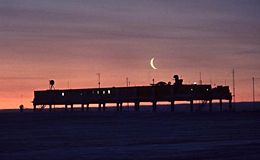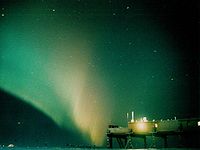
Halley Research Station
Encyclopedia

British Antarctic Survey
The British Antarctic Survey is the United Kingdom's national Antarctic operation and has an active role in Antarctic affairs. BAS is part of the Natural Environment Research Council and has over 400 staff. It operates five research stations, two ships and five aircraft in and around Antarctica....
, is located on the Brunt Ice Shelf
Brunt Ice Shelf
The Brunt Ice Shelf borders the Antarctic coast of Coats Land between Dawson-Lambton Glacier and Stancomb-Wills Glacier Tongue. It was the location of the base of the Royal Society Expedition, 1955–59 which was taken over as the British Halley Research Station...
floating on the Weddell Sea
Weddell Sea
The Weddell Sea is part of the Southern Ocean and contains the Weddell Gyre. Its land boundaries are defined by the bay formed from the coasts of Coats Land and the Antarctic Peninsula. The easternmost point is Cape Norvegia at Princess Martha Coast, Queen Maud Land. To the east of Cape Norvegia is...
in Antarctica. It is a British research facility dedicated to the study of the Earth's atmosphere
Earth's atmosphere
The atmosphere of Earth is a layer of gases surrounding the planet Earth that is retained by Earth's gravity. The atmosphere protects life on Earth by absorbing ultraviolet solar radiation, warming the surface through heat retention , and reducing temperature extremes between day and night...
. Measurement
Measurement
Measurement is the process or the result of determining the ratio of a physical quantity, such as a length, time, temperature etc., to a unit of measurement, such as the metre, second or degree Celsius...
s from Halley led to the discovery of the ozone hole in 1985.
History
Halley was founded in 1956, for the International Geophysical YearInternational Geophysical Year
The International Geophysical Year was an international scientific project that lasted from July 1, 1957, to December 31, 1958. It marked the end of a long period during the Cold War when scientific interchange between East and West was seriously interrupted...
of 1957-58, by an expedition from the Royal Society
Royal Society
The Royal Society of London for Improving Natural Knowledge, known simply as the Royal Society, is a learned society for science, and is possibly the oldest such society in existence. Founded in November 1660, it was granted a Royal Charter by King Charles II as the "Royal Society of London"...
. The bay where the expedition decided to set up their base was named Halley Bay, after the astronomer Edmond Halley
Edmond Halley
Edmond Halley FRS was an English astronomer, geophysicist, mathematician, meteorologist, and physicist who is best known for computing the orbit of the eponymous Halley's Comet. He was the second Astronomer Royal in Britain, following in the footsteps of John Flamsteed.-Biography and career:Halley...
. The name was changed to Halley in 1977 as the original bay had disappeared due to changes in the ice shelf.
The building
There have been five Halley bases built so far. The first four were all buried by snow accumulation and crushed until they were uninhabitable. Various construction methods were tried, from unprotected wooden huts to steel tunnels. Halley V has the main buildings built on steel platforms that are raised annually to keep them above the snow surface.A design competition was launched by the Royal Institute of British Architects
Royal Institute of British Architects
The Royal Institute of British Architects is a professional body for architects primarily in the United Kingdom, but also internationally.-History:...
and the British Antarctic Survey
British Antarctic Survey
The British Antarctic Survey is the United Kingdom's national Antarctic operation and has an active role in Antarctic affairs. BAS is part of the Natural Environment Research Council and has over 400 staff. It operates five research stations, two ships and five aircraft in and around Antarctica....
in June 2004 to provide a new design for Halley VI. The competition was entered by a number of architectural and engineering firms. In July 2005 the winning design was chosen, by Faber Maunsell and Hugh Broughton Architects. Servaccomm supplied modular accommodation pods for the new Halley VI station through Galliford Try International. The contract consisted of the manufacture of 26 pods in total, which were installed in eight modules providing fully serviced accommodation for 32 people.
It is a structure which is, like Halley V, jacked up on legs to keep it above the accumulation of snow. But unlike Halley V, there are skis on the bottom of these legs which allows the building to be relocated periodically.
Halley VI was built in Cape Town, South Africa by a South African consortium. The first sections were shipped to Antarctica in December 2007 and completion is expected during Nov/Dec 2011.
Environment
Temperatures at Halley rarely rise above 0°C although temperatures around -10°C are common on sunny summer days. Typical winter temperatures are below -20°C with extreme lows of around -55°C..
One of the reasons for the location of Halley is that it is under the auroral oval, resulting in frequent displays of the Aurora Australis overhead. These are easiest to see during the 105 days (29 Apr - 13 Aug) when the sun does not rise above the horizon.
Inhabitants
During winter there are usually around 16 overwintering staff. In the summer period, from late December to early March, this staff increases to around 70.It is often not clear from articles about Antarctic bases that very few of the winterers are scientists. Most are the technical specialists required to keep the station and the scientific experiments running. The wintering team at Halley includes a chef, a doctor, mechanics, an electrician, several electronics engineers and a heating and ventilation engineer.
One of the winterers each year is designated as the Base Commander and sworn in as a magistrate, this job is carried out in addition to their normal duties for a small additional salary.
1996 saw the first female winterers at Halley. There have been at least two women wintering every year until 2009.
Base life
Life in Antarctica is dominated by the seasons with a short hectic summer and a long winter. In bases such as Halley that are resupplied by sea the most significant event of the year is the arrival of the resupply ship (currently the , before 1999 the ) in late December. This is followed by intense activity to unload all supplies before the ship has to leave again - typically this is done in less than 2 weeks.The summer season is defined as the period between 'first call' when the ship first arrives and 'second call' in mid February when it returns to collect everyone who is not staying for the winter.
Once the ship has left the base is in winter mode with a small (16 ish) number of personnel remaining to run the base and conduct scientific research until the next summer.
Significant dates in the winter are sundown (last day when the sun can be seen) on Apr 29, midwinter (June 21) and sunup (first day when the sun rises after winter) on Aug 13. Traditionally the oldest person on base lowers the tattered flag on sundown and the youngest raises a new one on sunup. Midwinter is a week's holiday when a member of the wintering team is chosen to keep the old flag.
External links
Official website British Antarctic SurveyBAS Halley Research Station page
COMNAP Antarctic Facilities
COMNAP Antarctic Facilities Map

